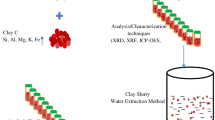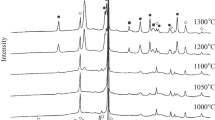Abstract
The relationship between composition and physical parameters such as specific surface area, cationic exchange capacity and plasticity is studied with the aim of developing regression models that would permit the prediction of clay properties. These models could be useful for mineralogists and industrial applications. Nineteen representative clay samples were collected from Jebel Ressas in north-eastern Tunisia. Mineralogical data show that clay samples cover a very large variety of minerals. The main clay mineral is illite (50–60 wt%), secondary minerals including quartz, calcite and minor amounts of Na-feldspar. This study reveals that the average amount of silica (SiO2) and alumina (Al2O3) are 51.9 and 19.6 wt%, respectively. The contents of lime (CaO) and iron (Fe2O3) vary between 4 and 8 wt% whereas the amount of alkalis (Na2O + K2O) is on average 4.1 wt%. The grain size data indicates a significant amount of silt fraction, and the fraction <2 µm varies between 23 and 35 wt%. Values for plasticity index range from 16 to 28 wt%. The cation exchange capacity and the specific surface values are 34.1–45.7 meq/100 g of air-dried clay and 302–374 m2/g, respectively. Lastly, regression models are used to correlate the properties with the mineralogical and chemical compositions. The significance and the validity of models were confirmed by statistical analysis and verification experiments. The regression models can be used to select the clay properties (plasticity index, cation exchange capacity and specific surface) in relation with clay minerals proportions and the finer fraction amounts.







Similar content being viewed by others
References
Ancey C (2007) Plasticity and geophysical flows: a review. J Non-Newton Fluid Mech 142(1–3):4–35
Bell FG, Coulthard JM (1997) A survey of some geotechnical properties of the Tees Laminate Clay of central Middlesbrough, North East England. Eng Geol 48:117–133
Ben M’Barek M, Srasra E, Zargouni F (2002) Caractérisation des argilites de Paléocène Nord Ouest de la Tunisie et leur utilisation dans le domaine de la céramique. Afr Geosci Rev 9(2):107–117
Besq A, Malfoy C, Pantet A, Monnet P, Righi D (2003) Physicochemical characterisation and flow properties of some bentonite muds. Appl Clay Sci 23:275–286
Carretero MI, Dondi M, Fabbri B, Raimondo M (2002) The influence of shaping and firing technology on ceramic properties of calcareous and non-calcareous illitic–chloritic clays. Appl Clay Sci 20:301–306
Casagrande A (1948) Plasticity chart for the classification of cohesive soils. Trans Am Soc Civ Eng 113:901
Cornell JA (2002) Experiments with mixtures: designs, models and the analysis of mixtures data, 3rd edn. Wiley, New York
Correia SL, Hotza D, Segadães SA (2004) Simultaneous optimization of linear firing shrinkage and water absorption of triaxial ceramic bodies using experiments design. Ceram Int 30:917–922
Diko ML, Ekosse GE, Ayonghe SN, Ntasin EB (2011) Physical characterization of clayey materials from tertiary volcanic cones in Limbe (Cameroon) for ceramic applications. Appl Clay Sci 51:380–384
El Hechi A (2004) Etude minéralogique et physico-chimique des séries argileuses du Crétacé-supérieur—Paléogène de la région de Grombalia, Zaghouan, et Enfidha. Thèse Doctorat. Faculté des Sciences de Tunis
Elkhazri A, Razgah S, Abdallah H, Ben Haj Ali N (2009) L’événement anoxique «OAE 1a» Barrémo-Aptien en Tunisie nordorientale: intérêt des foraminifères. Rev Paléobiol 28(1):93–130
Ferrari S, Gualtieri AF (2006) The use of illitic clays in the production of stoneware tile ceramics. Appl Clay Sci 32:73–81
Garzón E, Sánchez-Soto PJ, Romero E (2010) Physical and geotechnical properties of clay phyllites. Appl Clay Sci 48:307–318
Grim RE (1962) Applied clay mineral science. McGraw-Hill, New York
Holtz K, Kovacs WD (1981) Kansas geotechnical survey, current research in Earth Science. Bulletin 244, part 3, The Relationship between Geology and Landslide Hazards of Atchison, Kansas and Vicinity
Klaarenbeek FW (1961) The development of yellow colours in calcareous bricks. Trans Br Ceram Soc 60:739–771
Kreimeyer R (1987) Some notes on the firing colour of clay bricks. Appl Clay Sci 2:175–183
Lisboa JV, Carvalho JMF, Oliveira A, Carvalho C, Grade J (2007) A preliminary case study of potential ceramic raw materials in the Aileu area of Timor Leste. J Asian Earth Sci 29:593–603
Mahmoudi S, Srasra E, Zargouni F (2008) The use of Tunisian Barremian clay in the traditional ceramic industry: optimization of ceramic properties. Appl Clay Sci 42:125–129
Mahmoudi S, Srasra E, Zargouni F (2010) Firing behaviour of the lower cretaceous clays of Tunisia. J Afr Earth Sci 58:235–241
Meier LP, Nüesch R (1999) The lower cation exchange capacity limit of montmorillonite. J Colloid Interface Sci 217:77–85
Modesto C, Bernardin AM (2008) Determination of clay plasticity: indentation method versus Pfefferkorn method. Appl Clay Sci 40:15–19
Moussa L, Srasra E, Bouzouita K (1992) Stabilisation of clay suspension used in Tunisian ceramics. Mineral Petrogr Acta XXXV-A:147–159
Myers RH, Montgomery DC (2002) Response surface methodology: process and product optimisation using designed experiments. Wiley, New York
Proust C, Jullien A, Forestier L (2004) Détermination indirecte des limites d’Atterberg par gravimétrie dynamique. C R Geosci 335:175–183
Schmitz RM, Schroeder C, Charlier R (2004) Chemo-mechanical interactions in clay: a correlation between clay mineralogy and Atterberg limits. Appl Clay Sci 40:351–358
Sedmale G, Sperberga I, Sedmalis U, Valancius Z (2006) Formation of high-temperature crystalline phases in ceramic from illite clay and dolomite. J Eur Ceram Soc 26:3351–3355
Srasra E, Bergaya F, Van Damme H, Ariguib NK (1989) Surface properties of an activated bentonite—decolorisation of rape-seed oils. Appl Clay Sci 4:411–421
Środoń J (1981) X-ray identification of randomly interstratified illite/smectite in mixtures with discrete illite. Clay Miner 16:297–304
Strazzera B, Dondi M, Marsigli M (1997) Composition and ceramic properties of Tertiary clays from southern Sardinia (Italy). Appl Clay Sci 20:247–266
Turki MM (1988) Polycinématique et contrôle sédimentaire associé sur la cicatrice de Zaghouan–Nabhana. Revue des Sciences de la Terre. Édition de l’Institut National de Recherche Scientifique et Technique de Tunis, Tunisie, p 262
Van der Merwe DH (1964) Prediction of heave from the plasticity index and percentage of clay fraction of soils. Trans S Afr Inst Civ Eng 6:103–107
Wattanasiriwech D, Srijan K, Wattanasiriwech S (2009) Vitrification of illitic clay from Malaysia. Appl Clay Sci 43:57–62
Yu HS, Khong C, Wang J (2007) A unified plasticity model for cyclic behaviour of clay and sand. Mech Res Commun 34(2):97–114
Author information
Authors and Affiliations
Corresponding author
Rights and permissions
About this article
Cite this article
Mahmoudi, S., Srasra, E. & Zargouni, F. Identification and Simultaneous Optimisation of Tunisian Clay Properties: Preliminary Study for the Ceramic Products. Geotech Geol Eng 34, 817–825 (2016). https://doi.org/10.1007/s10706-016-0005-y
Received:
Accepted:
Published:
Issue Date:
DOI: https://doi.org/10.1007/s10706-016-0005-y




